AI as a collaborative partner in language learning: Part 1
 In the demanding world of teaching, where schedules overflow and responsibilities seem endless, educators consistently voice the desire for more time to refine their skills, all in pursuit of delivering impactful learning experiences to their students. According to a survey conducted by the EdWeek Research Center (2022), “the typical teacher works 54 hours per week, 25 hours of which is spent teaching students.” While the number of hours in the day isn’t exactly something that can be changed, the key lies in making processes more efficient, thus enabling educators to allocate valuable time toward refining their teaching methods and crafting those learning experiences that spark curiosity and empower learners to explore the world around them.
In the demanding world of teaching, where schedules overflow and responsibilities seem endless, educators consistently voice the desire for more time to refine their skills, all in pursuit of delivering impactful learning experiences to their students. According to a survey conducted by the EdWeek Research Center (2022), “the typical teacher works 54 hours per week, 25 hours of which is spent teaching students.” While the number of hours in the day isn’t exactly something that can be changed, the key lies in making processes more efficient, thus enabling educators to allocate valuable time toward refining their teaching methods and crafting those learning experiences that spark curiosity and empower learners to explore the world around them.
Enter Artificial Intelligence (AI).
AI is poised to play a pivotal role in revolutionizing the way teachers approach the many tasks that come with the title. In a 2023 Edutopia article, Rachelle Dené Poth details how AI can help, explaining that, “through AI-powered platforms, teachers are able to create lessons, activities, assessments, prompts for discussion, and presentations simply by providing a short prompt with keywords.” With potential for this kind of support, AI may very well serve as an invaluable assistant to teachers by not only saving teachers precious time but also enhancing the quality of lessons.
Efficient Lesson Planning with AI in Language Instruction
AI can swiftly – and fairly easily! – support language educators in crafting lessons that cater to the specific needs of their unique classrooms. The key word here though is support. As I will remind you throughout this section, AI should be used as a support for teachers, not as a substitute or replacement for our educators and the wealth of knowledge they possess. To contextualize this a bit, let’s focus specifically on language acquisition, providing suggestions for interactive exercises, ideas to support student-led inquiry projects, structures for pronunciation drills, and culturally relevant content. By leveraging AI, language teachers can ensure that their lessons are not only well-structured but also tailored to the individual linguistic needs of their students, fostering a more personalized and potentially more effective language learning environment.
AI streamlines the lesson planning process for language teachers, allowing for more efficient and effective preparation. McKinsey & Company predicted in a study titled “How Artificial Intelligence will Impact K-12 Teachers” (2020) that an estimated 20-40% of tasks teachers dedicate time to could be automated with technology. By automating routine tasks, AI empowers language educators to dedicate more time to developing engaging and immersive language learning experiences.
Boosting Teacher Creativity through AI in Language Instruction
Contrary to the misconception that AI stifles creativity in language planning and instruction, it acts as a catalyst for teacher innovation. By taking care of structural elements, adherence to language learning standards, and time parameters, AI frees up mental space for language teachers to unleash their creativity. Educators can infuse their unique teaching styles and imaginative language-learning approaches into lessons, transforming them from standardized language content delivery to engaging, culturally immersive experiences. In this symbiotic relationship, AI becomes a facilitator for creative expression, enhancing language lessons with real-world context and fostering a deeper understanding of linguistic nuances.
Curious to see how it works? Check out the example below in which I used ChatGPT to do some standards-based lesson planning for a Spanish World Languages class.
First: Define Your Standard Parameters
In this case, I want to start with my standards. For this example, I’m using ACTFL’s World-Readiness Standards for Learning Languages. With standards as the underlying framework for my lessons, I want to establish that my chosen AI (ChatGPT 3.5) has a good understanding of the learning objectives my lesson will need to achieve.
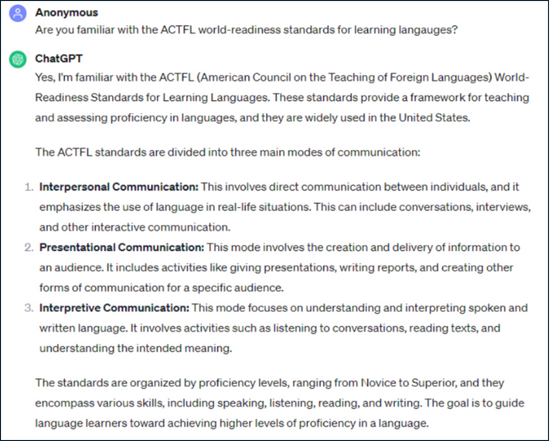
Next: Define Your Lesson Parameters
Now that I have established that ChatGPT understands my specific standards, I’ll jump into some lesson parameters – what grade am I teaching? Where am I teaching? What is the topic of instruction? How long should my lesson be?

I find that asking ChatGPT to essentially role-play as myself helps me to get better results, which is why you’ll see the use of the personal pronoun “you.” I’m essentially teaching this tool to respond in the ways I’d like for it to. More on that down below in the “revision” stage.
After That: Generate Your Lesson and Revise, Revise, REVISE!
With the input I provided, ChatGPT gave me a lesson plan that clearly stated my objectives, gave suggested materials, and broke down instruction into very manageable and easy-to-follow steps. What I liked most about the lesson it created was that each of the steps is labeled with the ACTFL standard it addressed, and the lesson as a whole was divided into introduction, direct instruction, guided practice, application, and closure sections.
Here are a few examples:
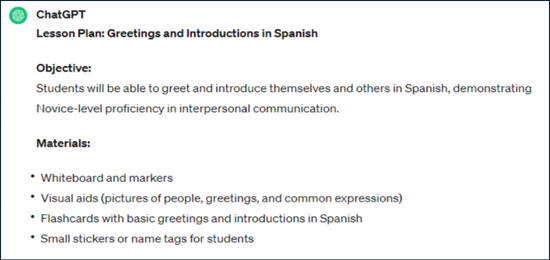
When I was in the classroom, I recall spending hours upon hours perfecting my lesson plans. By the time I got to thinking of the materials my students would need to be successful, my brain was fried. Even though these materials may not be exactly what teachers end up using, I appreciate the suggestions as they make me feel like I’m not doing this alone.
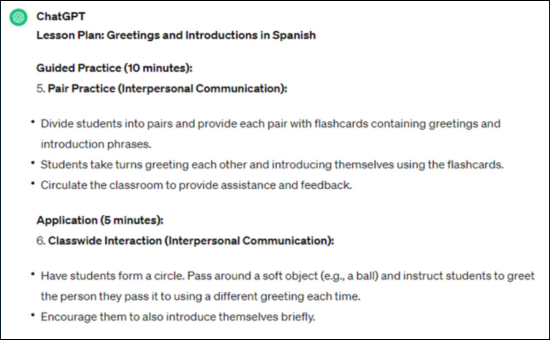
Let’s see how ChatGPT handles revisions, shall we?
My entire teaching career, I taught in International Baccalaureate schools. IB schools place a high level of importance on teaching through student-led inquiry. With that in mind, I wanted to see what ChatGPT would do if prompted to take student-led inquiry into consideration.
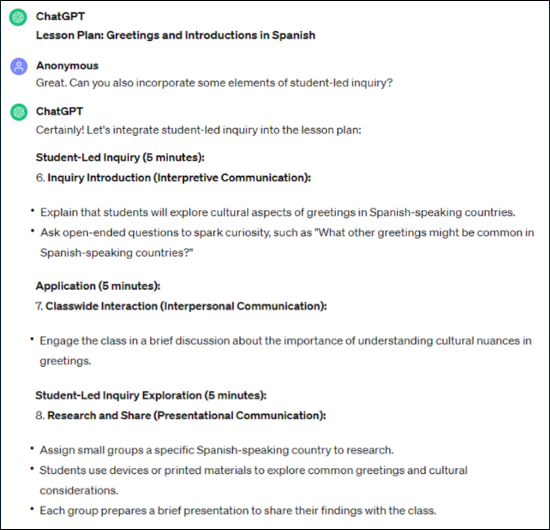
Obviously, student-led inquiry should be – as its name implies – led by students, so this would not completely cover that aspect of teaching within this lesson. However, our younger students may need a gentle nudge in the direction of “What types of questions could I be asking here?” What I like about ChatGPT’s output is that it introduces the inquiry (providing context for students), expands through application (giving meaning to their learning), and gives time for independent or small group exploration of and presentation on the topic of greetings in Spanish-speaking countries. I could see a teacher new to the field finding comfort in this framework, while a more seasoned teacher may take these ideas and expand on them, completely transforming the catalyst that AI so quickly provided.
The final prompt I left ChatGPT with was the task of brainstorming a possible assessment. See how that panned out below:
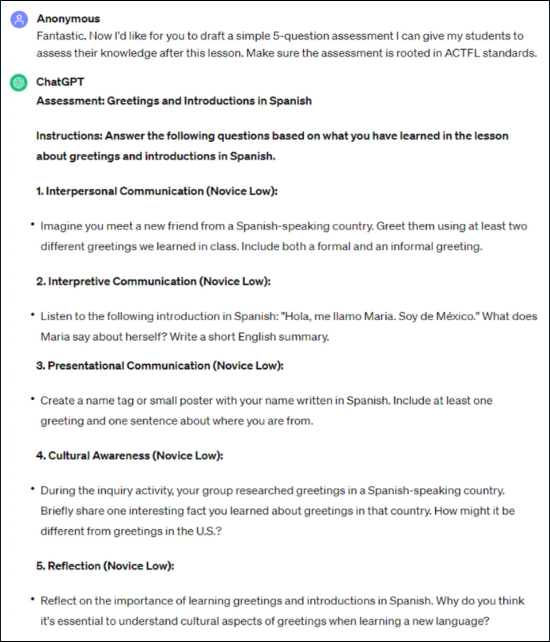
Pretty neat, right?
With two sentences, I was able to get ChatGPT to generate a pretty good outline for an assessment. My brain is buzzing with ideas for modifications I could make to this and extensions that would really make this assessment come to life!
Beyond: Honestly, continue revising until you reach a point of satisfaction with the AI output
From introduction through review, reflection, assessment, and revision, it took me about 20 minutes and a few extremely easy prompts to create this introductory lesson plan. Now, to be fair, I am not a world languages teacher now and never have been. This example was simply to illustrate that something like this is possible.
There will come a time in your exploration where you’ll think “Ok, this isn’t giving me anything new. It’s time to move on” and that’s ok! Remember: AI isn’t doing all of the work for you, it’s doing some of the work with you. As my colleague Emily says, “I’m a better editor sometimes than I am a content creator.” I don’t know about you, but I relate to that sentiment pretty hard.
Have fun with it! Try new things, explore new avenues of instruction, and don’t be afraid to scrap parts of the output that don’t fit in with what you’re trying to do. This is a pretty low-stakes planning adventure, and again, the ultimate goal is for some of the heavy lifting to be alleviated.
If you’re interested in seeing how AI can support you in your classroom planning but aren’t sure where or how to start, I recommend checking out Carl Hooker’s 12 AI-Enhanced Icebreakers To Motivate Learners. Sometimes, all you need to do to get started is break the ice!
AI as a Supportive Tool, Not a Replacement for Teacher Knowledge and Expertise
It is essential to view AI as a supportive tool rather than a complete replacement for the expertise and experience of language teachers. While AI brings valuable assistance to language education, it is inherently limited by the data it is trained on. Language teachers, as the ultimate experts in the language learning process, must practice fact-checking and critical evaluation. The synergy between AI and language teacher expertise ensures a comprehensive and effective approach to language education, where technology complements the human touch rather than supplants it. This collaborative approach safeguards against over-reliance on AI in language instruction, promoting a balanced and nuanced language learning experience that draws on the strengths of both technology and the nuanced understanding of language teachers.
Now let’s take a look at how AI can be supportive from the student perspective in Part Two of this blog!

Steph is an educator and lifelong learner with a strong teaching background at the early childhood and elementary levels. In addition to her classroom teaching experience, Steph has also served as an International Baccalaureate Primary Years Program Coordinator, delivering impactful professional development programs at the school and district levels. At Meg Languages, Steph works as a Product Innovation Lead, creating engaging products for language and culture learning, using innovative technology and pedagogical approaches to foster global citizenship among students. Connect with Steph on LinkedIn!
Share this post

